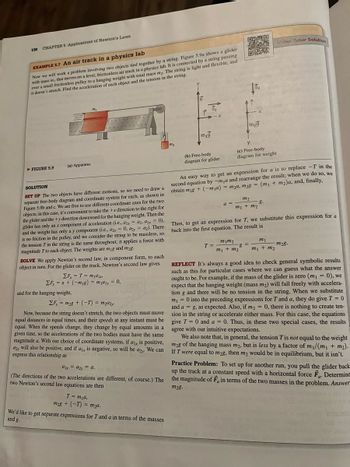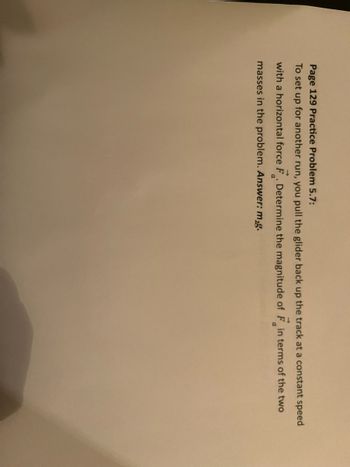
College Physics
11th Edition
ISBN: 9781305952300
Author: Raymond A. Serway, Chris Vuille
Publisher: Cengage Learning
expand_more
expand_more
format_list_bulleted
Question
The second image has background info used to help solve the practice problem.

Transcribed Image Text:130
CHAPTER 5 Applications of Newton's Laws
EXAMPLE 5.7 An air track in a physics lab
Now we will work a problem involving two objects tied together by a string. Figure 5.9a shows a glider
with mass m, that moves on a level, frictionless air track in a physics lab. It is connected by a string passing
over a small frictionless pulley to a hanging weight with total mass m₂. The string is light and flexible, and
it doesn't stretch. Find the acceleration of each object and the tension in the string.
►FIGURE 5.9
(a) Apparatus
SOLUTION
SET UP The two objects have different motions, so we need to draw a
separate free-body diagram and coordinate system for each, as shown in
Figure 5.9b and c. We are free to use different coordinate axes for the two
objects; in this case, it's convenient to take the +x direction to the right for
the glider and the +y direction downward for the hanging weight. Then the
glider has only an x component of acceleration (i.e., ax = a₁, a₁ = 0),
and the weight has only a y component (i.e., a2x = 0, a2y = a₂). There
is no friction in the pulley, and we consider the string to be massless, so
the tension T' in the string is the same throughout; it applies a force with
magnitude 7 to each object. The weights are mig and m2g.
SOLVE We apply Newton's second law, in component form, to each
object in turn. For the glider on the track, Newton's second law gives
ΣF₁ = T = max
EF, = n + (-m₁g) = m₁a₁y = 0,
and for the hanging weight,
EF, = m28 + (-T) = m₂a2y-
Now, because the string doesn't stretch, the two objects must move
equal distances in equal times, and their speeds at any instant must be
equal. When the speeds change, they change by equal amounts in a
given time, so the accelerations of the two bodies must have the same
magnitude a. With our choice of coordinate systems, if a₁x is positive,
azy will also be positive, and if a₁, is negative, so will be azy. We can
express this relationship as
alx = a2y = a.
(The directions of the two accelerations are different, of course.) The
two Newton's second law equations are then
T = mya,
m28 + (-T) = m₂a.
We'd like to get separate expressions for T and a in terms of the masses
and g.
m₂
m₁9
(b) Free-body
diagram for glider
DEXO
(n
F
X
m₂9
Y
(c) Free-body
diagram for weight
An easy way to get an expression for a is to replace -T in the
second equation by -m₁a and rearrange the result; when we do so, we
obtain m2g + (-ma) = m₂a, m2g = (m₁ + m₂)a, and, finally,
m1m2
T =
8 =
m₁ + m₂
m₂
8.
a =
m₁ + m₂
Video Tutor Solution
Then, to get an expression for T, we substitute this expression for a
back into the first equation. The result is
m1
m₁ + m₂
m₂8.
200
REFLECT It's always a good idea to check general symbolic results
such as this for particular cases where we can guess what the answer
ought to be. For example, if the mass of the glider is zero (m₁ = 0), we
expect that the hanging weight (mass m₂) will fall freely with accelera-
tion g and there will be no tension in the string. When we substitute
m₁ = 0 into the preceding expressions for T and a, they do give T = 0
and a = g, as expected. Also, if m₂ = 0, there is nothing to create ten-
sion in the string or accelerate either mass. For this case, the equations
give T = 0 and a = 0. Thus, in these two special cases, the results
agree with our intuitive expectations.
We also note that, in general, the tension T is not equal to the weight
m2g of the hanging mass m2, but is less by a factor of m₁/(m₁ + m₂).
If I were equal to m2g, then m₂ would be in equilibrium, but it isn't.
Practice Problem: To set up for another run, you pull the glider back
up the track at a constant speed with a horizontal force F. Determine
the magnitude of F, in terms of the two masses in the problem. Answer
m28.
18d) 2005
hile
wary

Transcribed Image Text:Page 129 Practice Problem 5.7:
To set up for another run, you pull the glider back up the track at a constant speed
with a horizontal force F. Determine the magnitude of F in terms of the two
a
a
masses in the problem. Answer: m₂g.
Expert Solution
This question has been solved!
Explore an expertly crafted, step-by-step solution for a thorough understanding of key concepts.
This is a popular solution
Trending nowThis is a popular solution!
Step by stepSolved in 4 steps with 2 images

Knowledge Booster
Learn more about
Need a deep-dive on the concept behind this application? Look no further. Learn more about this topic, physics and related others by exploring similar questions and additional content below.Similar questions
- G1) Answer the question shown in the imagearrow_forwardThe image produced by a concave mirror is located 27 cm in front of the mirror. The focal length of the mirror is 13 cm. How far in front of the mirror is the object located? Number i Unitsarrow_forwardThe question is in the image. Just to clarify the image in the diagram the numbers are 5.00m and 1.60marrow_forward
arrow_back_ios
arrow_forward_ios
Recommended textbooks for you
 College PhysicsPhysicsISBN:9781305952300Author:Raymond A. Serway, Chris VuillePublisher:Cengage Learning
College PhysicsPhysicsISBN:9781305952300Author:Raymond A. Serway, Chris VuillePublisher:Cengage Learning University Physics (14th Edition)PhysicsISBN:9780133969290Author:Hugh D. Young, Roger A. FreedmanPublisher:PEARSON
University Physics (14th Edition)PhysicsISBN:9780133969290Author:Hugh D. Young, Roger A. FreedmanPublisher:PEARSON Introduction To Quantum MechanicsPhysicsISBN:9781107189638Author:Griffiths, David J., Schroeter, Darrell F.Publisher:Cambridge University Press
Introduction To Quantum MechanicsPhysicsISBN:9781107189638Author:Griffiths, David J., Schroeter, Darrell F.Publisher:Cambridge University Press Physics for Scientists and EngineersPhysicsISBN:9781337553278Author:Raymond A. Serway, John W. JewettPublisher:Cengage Learning
Physics for Scientists and EngineersPhysicsISBN:9781337553278Author:Raymond A. Serway, John W. JewettPublisher:Cengage Learning Lecture- Tutorials for Introductory AstronomyPhysicsISBN:9780321820464Author:Edward E. Prather, Tim P. Slater, Jeff P. Adams, Gina BrissendenPublisher:Addison-Wesley
Lecture- Tutorials for Introductory AstronomyPhysicsISBN:9780321820464Author:Edward E. Prather, Tim P. Slater, Jeff P. Adams, Gina BrissendenPublisher:Addison-Wesley College Physics: A Strategic Approach (4th Editio...PhysicsISBN:9780134609034Author:Randall D. Knight (Professor Emeritus), Brian Jones, Stuart FieldPublisher:PEARSON
College Physics: A Strategic Approach (4th Editio...PhysicsISBN:9780134609034Author:Randall D. Knight (Professor Emeritus), Brian Jones, Stuart FieldPublisher:PEARSON

College Physics
Physics
ISBN:9781305952300
Author:Raymond A. Serway, Chris Vuille
Publisher:Cengage Learning

University Physics (14th Edition)
Physics
ISBN:9780133969290
Author:Hugh D. Young, Roger A. Freedman
Publisher:PEARSON

Introduction To Quantum Mechanics
Physics
ISBN:9781107189638
Author:Griffiths, David J., Schroeter, Darrell F.
Publisher:Cambridge University Press

Physics for Scientists and Engineers
Physics
ISBN:9781337553278
Author:Raymond A. Serway, John W. Jewett
Publisher:Cengage Learning

Lecture- Tutorials for Introductory Astronomy
Physics
ISBN:9780321820464
Author:Edward E. Prather, Tim P. Slater, Jeff P. Adams, Gina Brissenden
Publisher:Addison-Wesley

College Physics: A Strategic Approach (4th Editio...
Physics
ISBN:9780134609034
Author:Randall D. Knight (Professor Emeritus), Brian Jones, Stuart Field
Publisher:PEARSON